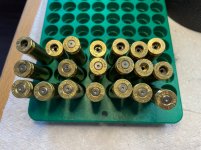So, after much thrashing trying to get a good load for my .260 Rem gasser, I finally arrived on one. I worked up (actually worked down - long story) a good load in Lapua brass using the Berger 130 AR Hybrid, 41.0 gr of IMR 4451 @2790 fps. Had no pressure signs with the Lapua brass and under .5 MOA accuracy at 100 yds. I had a match coming up this weekend and wanted to use my Virgin Prime brass as I didn't want to use my new 1x fired Lapua and lose it. The Prime stuff is quite a bit lighter weight and the case volume is larger than the Lapua. So I didn't expect there would be any problems loading the same 41.0 grain load. If anything it should be slower, right?
I went out the day prior to the match to get some dope with the new loads in the Prime brass and sure enough the same load in that Prime brass was about 40 fps slower than the heavier Lapua. Accuracy was fine. But I noticed that some of the Prime brass had a significant amount of swipe while others had none. Also almost all of the cases get the plunger mark on the head. The picture below is all the same Virgin brass, all with the same load and shot on the same day. Some of the swipe actually have some sharp edges where it carved into the brass head.
So the question is 1) why am I getting this much swipe when it's a fairly light load?? 2) And then why do some show lost of swipe swipe while others are completely fine and not marked. And finally, 3) some of the virgin brass I just shot was reloaded for the match and probably 69% of them had very loose primer pockets. I would not have expected that with a lighter loads.
Is there something going on that I am not seeing? Or is Prime really that shitty and I can expect to toss right away??
TIA
I went out the day prior to the match to get some dope with the new loads in the Prime brass and sure enough the same load in that Prime brass was about 40 fps slower than the heavier Lapua. Accuracy was fine. But I noticed that some of the Prime brass had a significant amount of swipe while others had none. Also almost all of the cases get the plunger mark on the head. The picture below is all the same Virgin brass, all with the same load and shot on the same day. Some of the swipe actually have some sharp edges where it carved into the brass head.
So the question is 1) why am I getting this much swipe when it's a fairly light load?? 2) And then why do some show lost of swipe swipe while others are completely fine and not marked. And finally, 3) some of the virgin brass I just shot was reloaded for the match and probably 69% of them had very loose primer pockets. I would not have expected that with a lighter loads.
Is there something going on that I am not seeing? Or is Prime really that shitty and I can expect to toss right away??
TIA
Attachments
Last edited:


